Advertisement - Click to support our sponsors.

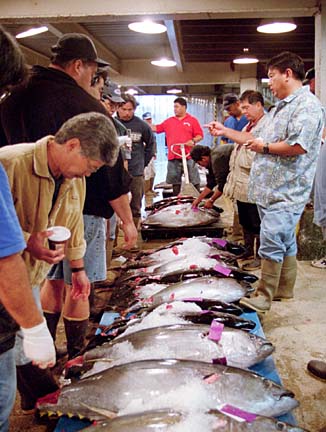
Organized chaos:
By Wilma Jandoc
Oahu’s fish auction
Star-BulletinKnowing the game and your opponent are the keys to victory.
Keeping these concepts in mind, Wayne Higashi says, is the most important aspect of his job as the auctioneer at United Fishing Agency on Ahui Street a few blocks from Kakaako Waterfront Park.
For 18 years, Higashi's job has gone far beyond shouting prices. He decides the opening price for as much as 175,000 pounds of fish sold in a day. He decides the lowest price he'll let a fish sell for. So he constantly researches the market and the buyers.
For the last 15 minutes before the six-day-a-week auction, he spends time alone to prepare himself mentally. Around him, the auction's 50 workers unload, weigh and arrange fish trucked in from nearby boats since 1 a.m. Workers move rumbling plastic pallets loaded with fish across the damp concrete floor. Stainless-steel knives gleam as cutters slice open a section of each fish near its tail for the buyers' inspection.
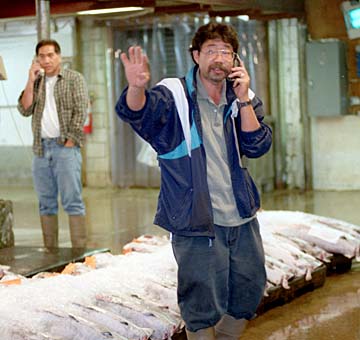
From 5:30 a.m. to as late as 5:30 p.m. on a busy day, there is constant movement and noise in the 14,000-square-foot building. A dozen things go on at once to keep the pipeline of fish from Pacific waters moving smoothly toward grocery stores, fish markets and restaurants. Approximately 60 percent of the overall supply is sold locally and the rest, mostly swordfish, is exported.The auction area is kept at about 60 degrees. Most buyers wear jeans, vests and knee-high rubber boots. When you first get there, the smell of fresh fish fills the air, but after being there half an hour, it's no longer noticeable.
About 10 buyers have already crowded around a pallet loaded with bigeye ahi, the first of about 40 pallets arranged in three rows. Buyers examine chunks of flesh pulled from the sample area cut on each fish. They look at firmness, fat and oil content, and color. Some even take a bite.
There are usually from 10 to 20 regular customers at the auction. Some represent companies that resell to local grocery store chains or restaurants. Others are exporters and store owners. Occasionally, a restaurant chef will drop by. Promptly at 5:30 a.m., assistant auctioneer Tipasa Godfrey rings a cracked brass bell announcing the auction's start.
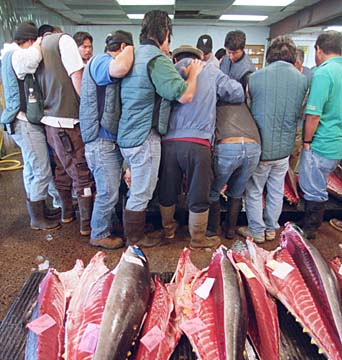
Higashi takes his place on the auction floor, standing at the head of the first pallet of fish. Various information floats through his head: today's and tomorrow's fish supply; conversations with buyers; upcoming special events such as New Year's; and even local fish ads he's seen.With all this in mind, Higashi examines the fish with a quick glance. Finally he barks out, "Ahi, 70 lbs. Let's start at $4.20!''
His sharp eyes keep track of nearly 30 people, including private individuals, at the auction's peak. But, he says, "You might have 20 people around you, but you're not watching all of them.
"You get to know their (buyers') personalities, their clientele. You know what size of fish they usually buy. So you know which people to watch.''
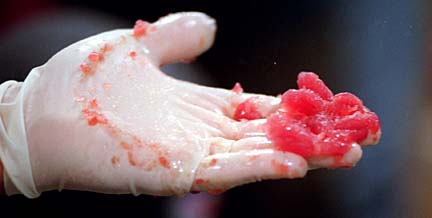
He also knows what to watch for. Higashi catches the raised eyebrows, long looks, outstretched hands, slight forward leans and muffled grunts that signal bids.In this way, fish are sold individually. One 49-lb. ahi begins at $2.80 per pound, bandies back and forth between two buyers and ends at $3.30 -- before a surprise last-minute bid by a third buyer ups it to $3.60. Fish are sold in the order that boats returned to dock. First are the longline catch, which make up the bulk of the auction's volume. Tunas have priority because of their value and volume. Next are marlins and by-catch such as ono and mahimahi. Then the unsold longline fish are brought out again. Then come neighbor-island and foreign imports, local small-boat fish, then bottomfish such as onaga.
Swordfish, which are beheaded, de-tailed and gutted before arriving at the auction house, are sold last in a separate auction. On this day, Godfrey starts the swordfish auction at 10:30 a.m. with about five buyers, all equipped with cellular phones to confer with their clients or supervisors.
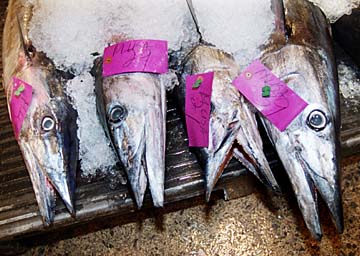
The atmosphere can be more comic, especially with the antics of two younger buyers, Keola and Terrence.Buyers often have nicknames for each other. "Sunshine'' is always smiling. "Speedy'' takes a long time to bid. And "Princess'' is a male buyer who enjoys making a grand entrance.
"Sometimes there's a lot of tension, trying to figure out what the game is," Higashi says. Humor among participants is "a tension-breaker.''
Since much of the swordfish is exported by air, they are arranged in batches that weigh 2,900 pounds -- just the right weight for standard airline containers.
Today, Row 2, at 2,851 lbs. total, closes at $5.05 a pound.
The fish auction is an organized chaos with many different realities. Hundreds of fish with varying quality and prices, buyers' different demands and clientele, seasonality and many other factors make it difficult to talk of an "average" day at the auction.
Perhaps the only constant is its competitive nature. "This type of auction, the way it's set up, encourages interaction," Higashi says. "I'm trying to mediate, make sure the buyers get the fish they want, but also get a good price for the fish."
That way, everybody wins the game.